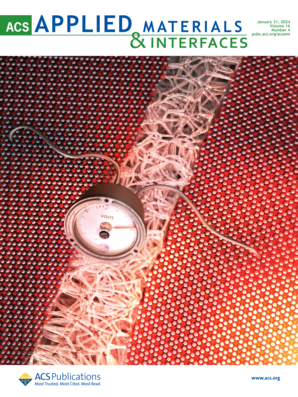Probing the Effects of Dimethyl Aluminum Isopropoxide Surface Reaction Byproducts on Atomic Layer Deposition Nucleation
IF 8.3
2区 材料科学
Q1 MATERIALS SCIENCE, MULTIDISCIPLINARY
引用次数: 0
Abstract
Atomic layer deposition (ALD) processes that leverage a myriad of metal–organic and complementary reactant combinations have been identified to realize precise and conformal thin film growth. However, the effects of the ALD reaction byproducts on nucleation and growth mechanisms are rarely considered. Site-selective ALD processes provide an opportunity for the detailed investigation of uniform surface sites with atomistic accuracy. Intentional pretreatment with a known ALD reaction byproduct – isopropanol – enables a significant improvement in the nucleation rate reproducibility of dimethylaluminum isopropoxide and water ALD on rutile TiO2(110). In situ spectroscopic ellipsometry reveals a partially reversible byproduct binding that is site-selective for TiO2(110) surface oxygen vacancies. First-principles calculations reveal surface site-specific thermodynamics for adsorption of isopropanol and water that may influence ALD nucleation. The sensitivity of site-selective ALD motivates consideration of secondary surface reactions when designing precision deposition processes, including area- or site-selective ALD reactions.

探讨二甲基异丙醇铝表面反应副产物对原子层沉积成核的影响
原子层沉积(ALD)工艺利用了无数的金属有机和互补的反应物组合来实现精确和保形的薄膜生长。然而,ALD反应副产物对成核和生长机制的影响很少被考虑。位置选择性ALD工艺为均匀表面位置的原子精度的详细调查提供了机会。用已知的ALD反应副产物-异丙醇进行预处理,可以显著提高二甲基异丙醇铝和水ALD在金红石型TiO2上的成核率和再现性(110)。原位椭偏光谱显示了部分可逆的副产物结合,对TiO2(110)表面氧空位具有位点选择性。第一性原理计算揭示了异丙醇和水吸附的表面位置特定热力学,这可能会影响ALD成核。位置选择性ALD的敏感性促使在设计精密沉积工艺时考虑二次表面反应,包括区域或位置选择性ALD反应。
本文章由计算机程序翻译,如有差异,请以英文原文为准。
求助全文
约1分钟内获得全文
求助全文
来源期刊

ACS Applied Materials & Interfaces
工程技术-材料科学:综合
CiteScore
16.00
自引率
6.30%
发文量
4978
审稿时长
1.8 months
期刊介绍:
ACS Applied Materials & Interfaces is a leading interdisciplinary journal that brings together chemists, engineers, physicists, and biologists to explore the development and utilization of newly-discovered materials and interfacial processes for specific applications. Our journal has experienced remarkable growth since its establishment in 2009, both in terms of the number of articles published and the impact of the research showcased. We are proud to foster a truly global community, with the majority of published articles originating from outside the United States, reflecting the rapid growth of applied research worldwide.
 求助内容:
求助内容: 应助结果提醒方式:
应助结果提醒方式:


